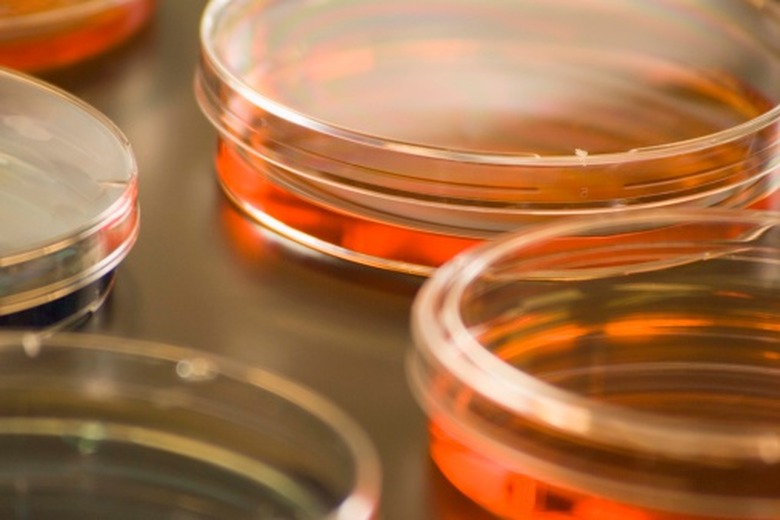Different Agar Plates
Agar is the medium found in a petri dish. It appears gelatinous. Generally speaking, agar is comprised of sugar and an extract from red algae. Scientists and students use agar to grow bacterial cultures for research. Scientists use different types of agar in the lab because different types of agar prefer different types of bacteria. Some agar types are suitable for student use and some are not.
Suitable for Students: Nutrient Agar
Suitable for Students: Nutrient Agar
Agar plates with a simple nutrient formulation are safest for student use because they will not culture potentially harmful bacteria. The growth medium consists of beef broth and yeast extracts. You will find these plates labeled "Nutrient Agar." A common type of nutrient agar is LB agar, which stands for "lysogeny broth." Miller's LB derives from LB agar. It uses the same basic nutrients as LB agar but in different proportions.
Unsuitable for Students: Easily Contaminated
Unsuitable for Students: Easily Contaminated
Some agar formulations can be easily contaminated outside of sterile laboratory conditions. For this reason, they don't work well for students at school or home science enthusiasts, both of whom generally do not culture bacteria in a sterile environment. These types of agar include blood agar, which is made from sheep's blood; and chocolate agar, which is a blood agar containing additives that help fastidious bacteria, or bacteria with greater environmental and nutritional requirements, to grow.
Unsuitable for Students: Highly Selective Growth Media
Unsuitable for Students: Highly Selective Growth Media
Some types of agar are designed to culture specific types of highly selective bacteria. These bacteria encounter difficulty growing on any other medium. These highly-selective media preferentially culture Gram-negative bacteria, which are those bacteria that do not retain the purple dye of the Gram test. Gram-negative bacteria are often pathogenic to humans, adding an extra layer of caution to the use of these agar plates. MacConkey agar, for example, only cultures Gram-negative bacteria, including E.coli. XLD agar, another highly selective medium, inhibits Gram-positive bacteria while encouraging Gram-negative bacteria. XLD agar is used primarily for culturing pathogens found in stool samples.
Unsuitable for Students: Preferentially Pathogenic
Unsuitable for Students: Preferentially Pathogenic
A final category of agar utilizes antibiotic additives to culture specific antibiotic-resistant bacteria while killing all other bacterial competitors on the agar plate. Neomycin agar, for example, inhibits the growth of all but streptococcus bacteria. streptococcus, or "strep," are the bacteria responsible for diseases like strep throat. In addition, neomycin is toxic to people and may cause allergic reactions in some. Another agar used for culturing pathogens is sabouraud agar. Sabouraud agar, which contains the antibiotic gentamicin, kills most bacteria but preferentially cultures the fungi responsible for hair, skin and nail infections.
Cite This Article
MLA
Flanigan, Erin. "Different Agar Plates" sciencing.com, https://www.sciencing.com/different-agar-plates-8040091/. 24 April 2017.
APA
Flanigan, Erin. (2017, April 24). Different Agar Plates. sciencing.com. Retrieved from https://www.sciencing.com/different-agar-plates-8040091/
Chicago
Flanigan, Erin. Different Agar Plates last modified March 24, 2022. https://www.sciencing.com/different-agar-plates-8040091/
